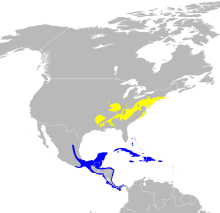Worm-eating warbler
| Worm-eating warbler | |
|---|---|
 |
|
| Scientific classification | |
| Kingdom: | Animalia |
| Phylum: | Chordata |
| Class: | Aves |
| Order: | Passeriformes |
| Family: | Parulidae |
| Genus: |
Helmitheros Rafinesque, 1819 |
| Species: | H. vermivorum |
| Binomial name | |
|
Helmitheros vermivorum (Gmelin 1789) |
|
 |
|
| Range of H. vermivorum Breeding range Winter range | |
| Synonyms | |
|
Helmitheros vermivorus |
|
Helmitheros vermivorus
(Gmelin, 1789)
The worm-eating warbler (Helmitheros vermivorum) is a small New World warbler that breeds in the Eastern United States and migrates to southern Mexico and Central America for the winter.
The worm-eating warbler is the only species currently classified in the genus Helmitheros. However, Swainson's warbler has previously been in this genus as H. swainsonii.
The worm-eating warbler is a small New World warbler. It is 13 cm (5.1 in) long and weighs 13 g (0.46 oz). It is relatively plain with olive-brown upperparts and light-coloured underparts, but has black and light brown stripes on its head. It has a slim pointed bill and pink legs. In immature birds, the head stripes are brownish. The male's song is a short high-pitched trill. This bird's call is a chip or tseet. Worm-eating warblers are sexually monomorphic. Males and females can only reliably be sexed during the breeding season by the presence of a brood patch in females or a cloacal protuberance in males. These birds are also difficult to age. Hatch year/second year birds have rusty tips on tertials that wear off by March of the following year. Juveniles can be distinguished by duskier head markings, and cinnamon wingbars.
This bird breeds in dense deciduous forests in the eastern United States, usually on wooded slopes. The nest is an open cup placed on the ground, hidden among dead leaves. It is one of five species of new-world warblers that nests on the ground including the black-and-white warbler (Mniotilta varia), the ovenbird (Seiurus aurocapilla), the northern waterthrush (Parkesia noveboracensis), Louisiana waterthrush (Parkesia motacilla), and the Kentucky warbler (Geothlypis formosa). The female lays four or five eggs. Both parents feed the young; they may try to distract predators near the nest by pretending to be injured. Worm-eating warblers are often parasitized by brown-headed cowbirds (Molothrus ater) where forest fragmentation occurs. Reducing forest fragmentation may prove vital if populations of worm-eating warblers suffer large declines.
...
Wikipedia

